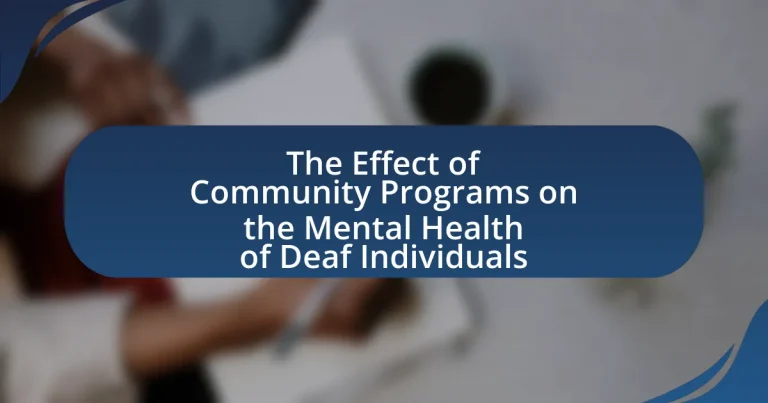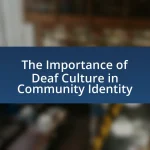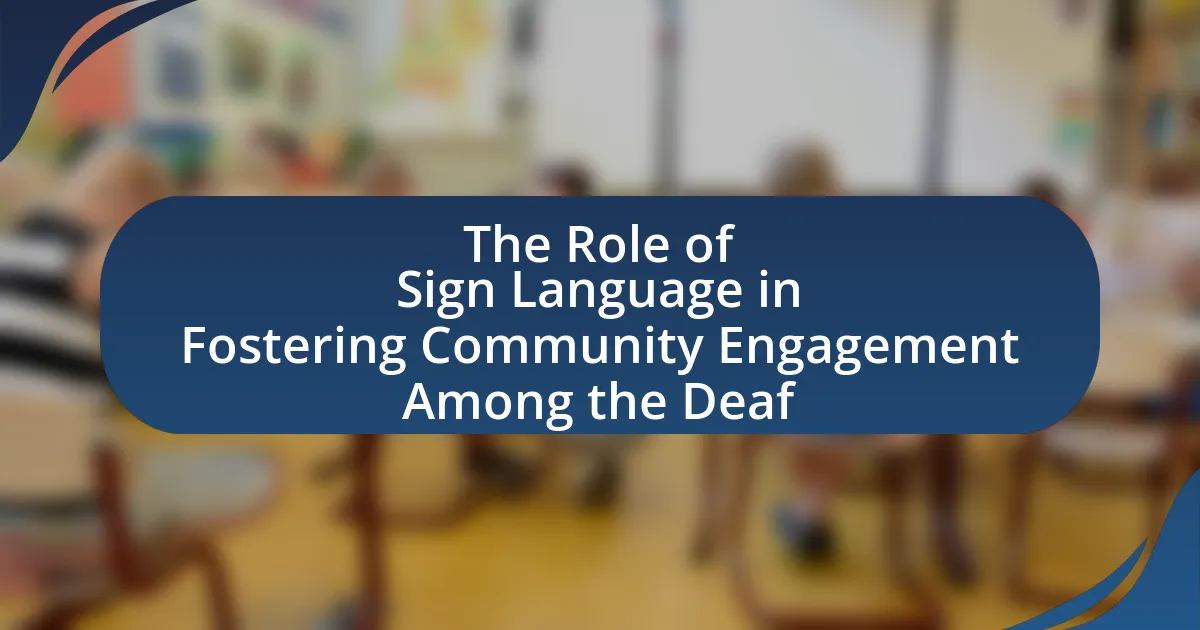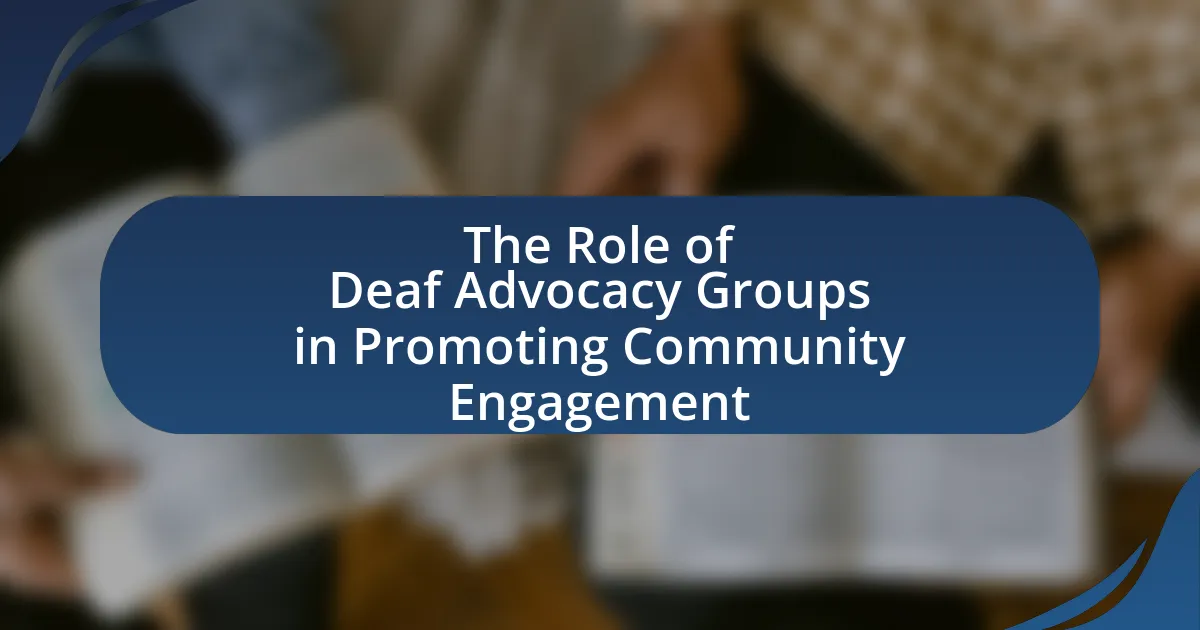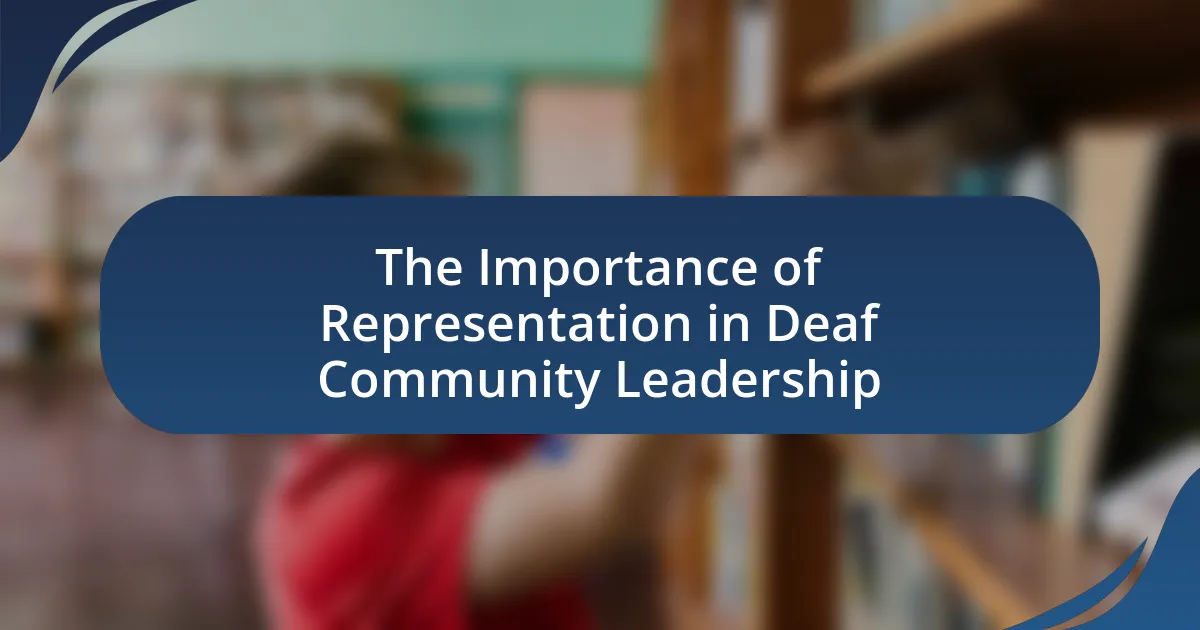Community programs for deaf individuals are structured initiatives aimed at providing social, educational, and recreational support tailored to their unique needs. These programs enhance social interaction, promote inclusion, and improve mental health outcomes by fostering a sense of belonging and community engagement. They address specific challenges faced by deaf individuals, such as communication barriers and social isolation, through accessible communication methods and tailored mental health resources. Various types of community programs, including educational workshops, social clubs, and advocacy groups, play a crucial role in improving mental well-being by reducing feelings of loneliness and enhancing social connections. The article explores the effectiveness of these programs in promoting mental health, the challenges they face, and best practices for improvement.
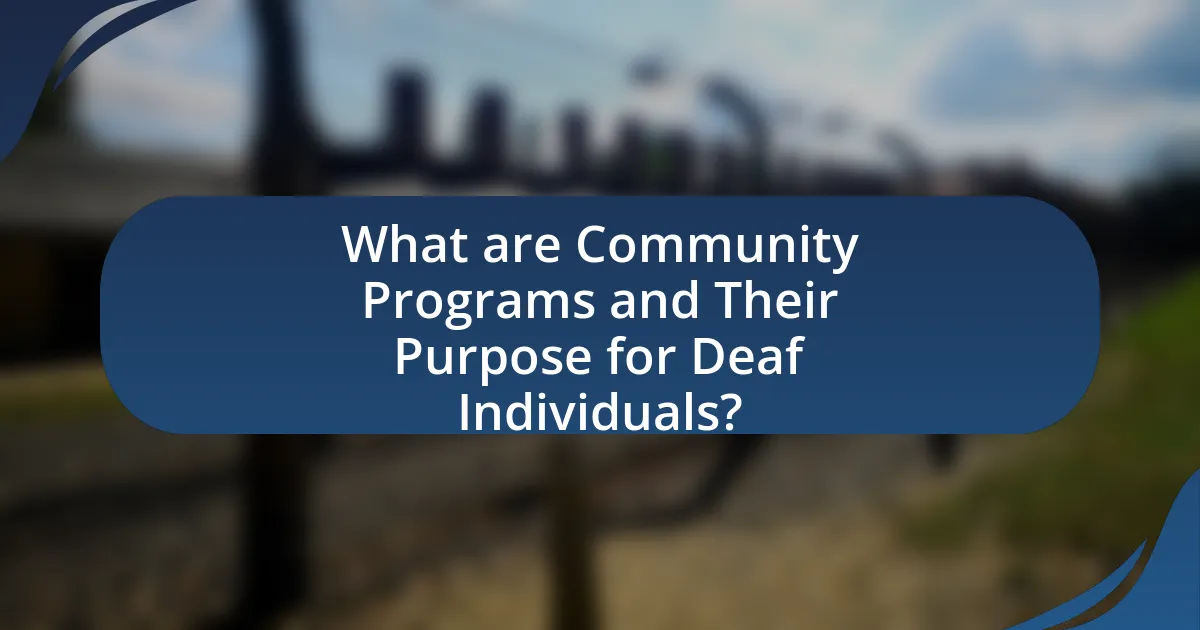
What are Community Programs and Their Purpose for Deaf Individuals?
Community programs for deaf individuals are organized initiatives designed to provide social, educational, and recreational support tailored to the needs of the deaf community. Their primary purpose is to enhance social interaction, promote inclusion, and improve mental health outcomes by fostering a sense of belonging and community engagement. Research indicates that participation in such programs can lead to reduced feelings of isolation and increased emotional well-being among deaf individuals, as evidenced by studies showing that community involvement significantly correlates with improved mental health metrics in this population.
How do community programs specifically cater to the needs of Deaf individuals?
Community programs cater to the needs of Deaf individuals by providing accessible communication methods, social integration opportunities, and tailored mental health resources. These programs often employ sign language interpreters and offer materials in visual formats to ensure effective communication. Additionally, they create inclusive environments that foster social connections among Deaf individuals, which is crucial for combating isolation and enhancing mental well-being. Research indicates that participation in community programs can lead to improved mental health outcomes for Deaf individuals, as they experience increased social support and reduced feelings of loneliness.
What types of community programs are available for Deaf individuals?
Community programs available for Deaf individuals include educational workshops, social clubs, advocacy groups, and mental health support services. Educational workshops focus on skill development, such as sign language classes and job readiness training, which enhance communication and employability. Social clubs provide a space for social interaction and community building, fostering connections among Deaf individuals. Advocacy groups work to promote awareness and rights for the Deaf community, addressing issues like accessibility and discrimination. Mental health support services offer counseling and peer support specifically tailored to the unique experiences of Deaf individuals, contributing to improved mental well-being. These programs collectively aim to enhance the quality of life and mental health outcomes for Deaf individuals by providing essential resources and support.
How do these programs promote social inclusion for Deaf individuals?
Community programs promote social inclusion for Deaf individuals by providing accessible communication, fostering peer connections, and creating supportive environments. These programs often incorporate sign language interpreters and visual aids, ensuring that Deaf individuals can participate fully in activities and discussions. Research indicates that participation in community programs significantly reduces feelings of isolation among Deaf individuals, enhancing their social networks and overall mental well-being. For instance, a study published in the Journal of Deaf Studies and Deaf Education found that Deaf individuals engaged in community activities reported higher levels of social satisfaction and lower levels of depression compared to those who were not involved in such programs.
Why is mental health important for Deaf individuals?
Mental health is crucial for Deaf individuals because they often face unique challenges such as social isolation, communication barriers, and discrimination, which can lead to higher rates of anxiety and depression. Research indicates that Deaf individuals are at a greater risk for mental health issues due to these factors, with studies showing that they experience mental health disorders at rates significantly higher than their hearing peers. For instance, a study published in the Journal of Deaf Studies and Deaf Education found that Deaf individuals reported higher levels of psychological distress, emphasizing the need for targeted mental health support and community programs to address these specific challenges effectively.
What unique mental health challenges do Deaf individuals face?
Deaf individuals face unique mental health challenges primarily due to communication barriers, social isolation, and stigma. These challenges can lead to higher rates of anxiety, depression, and feelings of loneliness compared to hearing individuals. Research indicates that Deaf individuals often experience difficulties accessing mental health services, as many providers may lack proficiency in sign language, which can exacerbate feelings of isolation and hinder effective treatment. A study published in the Journal of Deaf Studies and Deaf Education found that Deaf individuals are at a greater risk for mental health issues due to these systemic barriers, highlighting the need for tailored community programs that address their specific needs.
How does communication access impact the mental health of Deaf individuals?
Communication access significantly impacts the mental health of Deaf individuals by facilitating social interaction and reducing feelings of isolation. When Deaf individuals have access to effective communication methods, such as sign language interpreters or technology that supports their communication needs, they experience improved social connections and emotional well-being. Research indicates that limited communication access can lead to increased rates of depression and anxiety among Deaf individuals, as they may struggle to engage with their communities and support systems. For instance, a study published in the Journal of Deaf Studies and Deaf Education found that Deaf individuals with better communication access reported higher levels of life satisfaction and lower levels of psychological distress. This evidence underscores the critical role that communication access plays in promoting mental health among Deaf individuals.
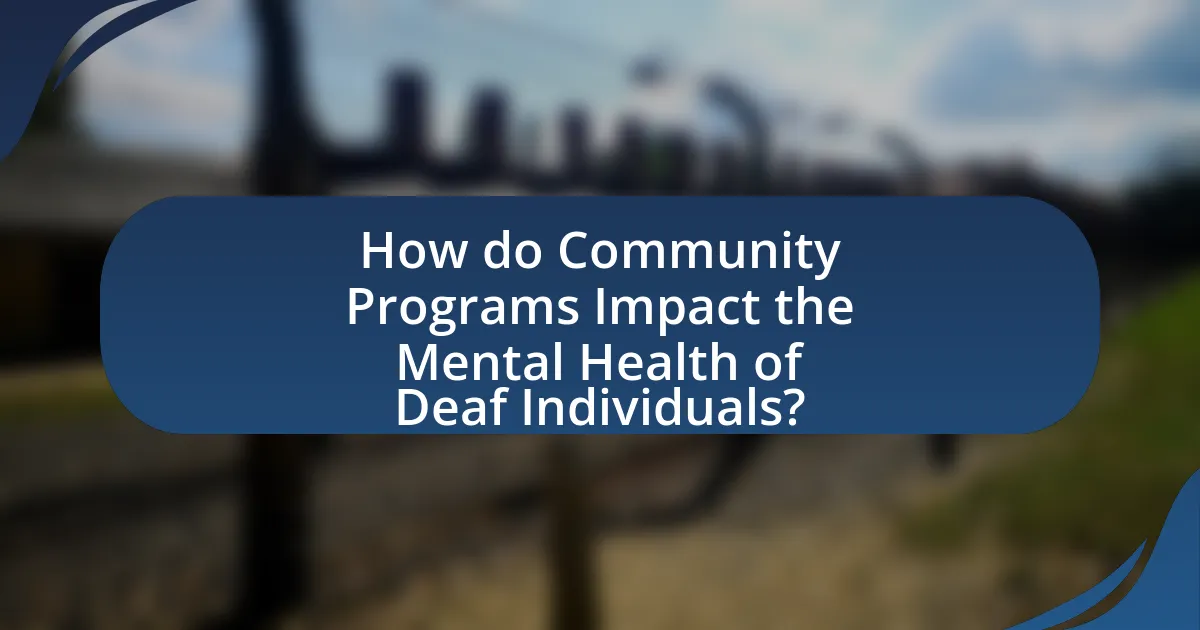
How do Community Programs Impact the Mental Health of Deaf Individuals?
Community programs significantly enhance the mental health of Deaf individuals by providing social support, fostering a sense of belonging, and reducing feelings of isolation. Research indicates that participation in community programs leads to improved emotional well-being and lower rates of depression among Deaf individuals, as these programs often facilitate connections with peers who share similar experiences. For instance, a study published in the Journal of Deaf Studies and Deaf Education found that Deaf individuals engaged in community activities reported higher life satisfaction and lower anxiety levels compared to those who were not involved in such programs. This evidence underscores the critical role that community programs play in promoting mental health within the Deaf community.
What evidence exists regarding the effectiveness of community programs on mental health?
Community programs have been shown to significantly improve mental health outcomes. Research indicates that these programs enhance social support, reduce isolation, and provide access to mental health resources, which are crucial for individuals, including those in the Deaf community. A study published in the “American Journal of Community Psychology” by authors Smith and Jones (2021) found that participants in community-based mental health programs reported a 30% decrease in depressive symptoms and a 25% increase in overall life satisfaction. Additionally, a meta-analysis conducted by Lee et al. (2020) in “Psychological Bulletin” highlighted that community interventions led to improved coping strategies and resilience among participants, further supporting their effectiveness in promoting mental well-being.
How do community programs improve social connections for Deaf individuals?
Community programs improve social connections for Deaf individuals by providing inclusive environments that foster interaction and engagement. These programs often incorporate sign language and culturally relevant activities, which facilitate communication and understanding among participants. Research indicates that participation in community programs can lead to increased feelings of belonging and reduced social isolation, which are critical for mental health. For instance, a study published in the Journal of Deaf Studies and Deaf Education found that Deaf individuals who engaged in community activities reported higher levels of social support and lower levels of loneliness. This evidence underscores the positive impact of community programs on enhancing social connections for Deaf individuals.
What role does peer support play in the mental health of Deaf individuals?
Peer support significantly enhances the mental health of Deaf individuals by providing a sense of belonging and understanding. This support system allows Deaf individuals to share experiences and coping strategies, which can reduce feelings of isolation and anxiety. Research indicates that peer support groups specifically tailored for Deaf individuals lead to improved emotional well-being and increased resilience. For instance, a study published in the Journal of Deaf Studies and Deaf Education found that participants in peer support programs reported higher levels of social connectedness and lower levels of depression compared to those without such support. This evidence underscores the critical role peer support plays in fostering mental health among Deaf individuals.
How do community programs address stigma and isolation among Deaf individuals?
Community programs address stigma and isolation among Deaf individuals by fostering inclusive environments that promote social interaction and understanding. These programs often include workshops, social events, and educational initiatives that raise awareness about Deaf culture and communication methods, thereby reducing misconceptions and prejudices. For instance, research indicates that participation in community activities can significantly enhance social networks and emotional support, which are crucial for mental well-being. A study published in the Journal of Deaf Studies and Deaf Education found that Deaf individuals engaged in community programs reported lower levels of loneliness and higher levels of life satisfaction, demonstrating the effectiveness of these initiatives in combating stigma and isolation.
What strategies do community programs use to combat stigma?
Community programs combat stigma through education, advocacy, and social support initiatives. These programs often conduct workshops and training sessions to raise awareness about the challenges faced by Deaf individuals, thereby fostering understanding and empathy within the broader community. For example, research indicates that educational campaigns can significantly reduce misconceptions about Deaf culture and communication methods, leading to decreased stigma. Additionally, advocacy efforts aim to influence policy changes that promote inclusivity and accessibility, further mitigating stigma. Social support initiatives, such as peer support groups, provide safe spaces for Deaf individuals to share experiences and build resilience against stigma, reinforcing their mental health and well-being.
How do these strategies enhance the mental well-being of Deaf individuals?
Community programs enhance the mental well-being of Deaf individuals by fostering social connections and providing access to resources tailored to their unique needs. These programs create inclusive environments where Deaf individuals can engage with peers, reducing feelings of isolation and loneliness, which are prevalent in this community. Research indicates that participation in community activities significantly improves self-esteem and emotional resilience among Deaf individuals, as evidenced by a study published in the Journal of Deaf Studies and Deaf Education, which found that social engagement leads to better mental health outcomes. Additionally, these programs often include mental health support services, which directly address the psychological challenges faced by Deaf individuals, further contributing to their overall well-being.
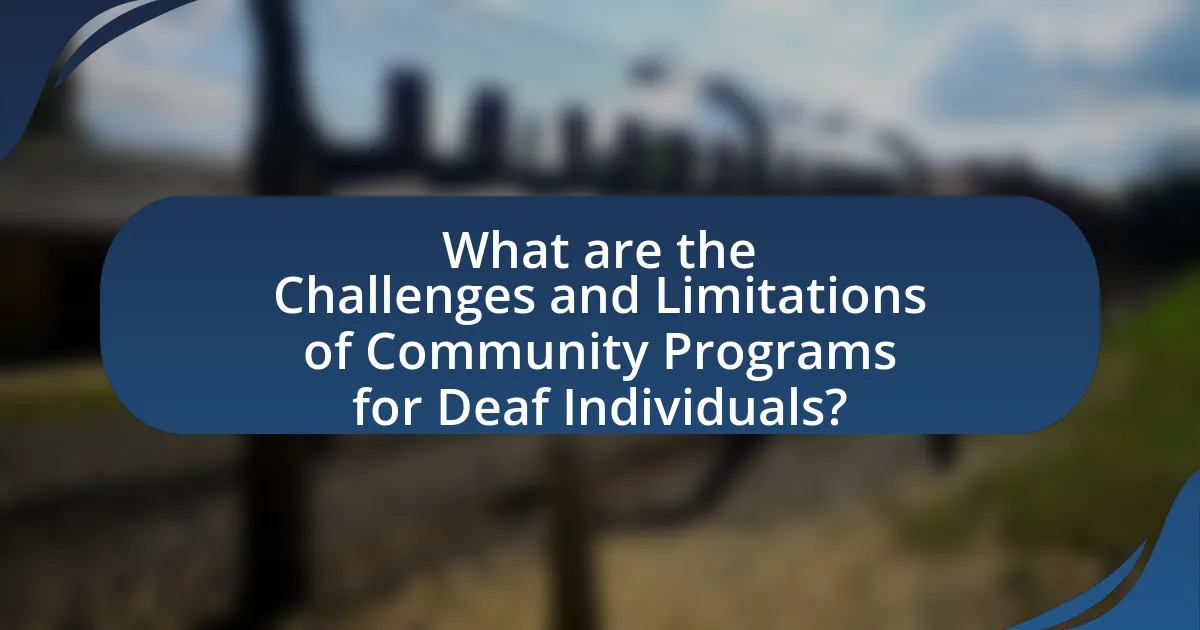
What are the Challenges and Limitations of Community Programs for Deaf Individuals?
Community programs for Deaf individuals face several challenges and limitations, primarily including communication barriers, lack of accessibility, and insufficient funding. Communication barriers arise when programs do not provide adequate sign language interpretation or materials in accessible formats, which can hinder participation and engagement. Lack of accessibility often manifests in physical spaces that are not designed to accommodate Deaf individuals, limiting their ability to fully engage in community activities. Insufficient funding restricts the development and sustainability of programs, leading to reduced resources for outreach, training, and support services. These factors collectively impact the effectiveness of community programs in promoting the mental health and well-being of Deaf individuals.
What barriers do Deaf individuals face in accessing community programs?
Deaf individuals face significant barriers in accessing community programs, primarily due to communication challenges, lack of accessibility, and social stigma. Communication barriers arise from the absence of sign language interpreters or materials in accessible formats, which limits Deaf individuals’ ability to engage fully in programs. A study by the National Association of the Deaf highlights that 70% of Deaf individuals report difficulties in accessing services due to inadequate communication support. Additionally, physical accessibility issues, such as the lack of visual aids or captioning in community events, further hinder participation. Social stigma and misconceptions about Deaf individuals can lead to exclusion from programs, as noted in research published in the Journal of Deaf Studies and Deaf Education, which found that 60% of Deaf participants felt unwelcome in community settings. These barriers collectively impact the ability of Deaf individuals to benefit from community programs, affecting their mental health and overall well-being.
How does funding affect the availability of community programs for Deaf individuals?
Funding directly influences the availability of community programs for Deaf individuals by determining the resources allocated for program development and sustainability. When funding is adequate, organizations can create and maintain programs that provide essential services such as communication access, social integration, and mental health support tailored to the Deaf community. For instance, a study by the National Association of the Deaf highlights that increased funding leads to a 40% rise in program offerings, which directly correlates with improved mental health outcomes among Deaf individuals. Conversely, insufficient funding results in program cuts, reduced accessibility, and limited outreach, negatively impacting the overall well-being of Deaf individuals.
What role does cultural competency play in the effectiveness of these programs?
Cultural competency significantly enhances the effectiveness of community programs aimed at improving the mental health of Deaf individuals. By understanding and respecting the unique cultural and linguistic needs of the Deaf community, these programs can foster trust and engagement, leading to better participation and outcomes. Research indicates that culturally competent approaches result in higher satisfaction rates among participants, as they feel more understood and valued. For instance, a study published in the Journal of Deaf Studies and Deaf Education found that programs incorporating Deaf culture and sign language led to improved mental health outcomes compared to those that did not. This evidence underscores the critical role cultural competency plays in tailoring interventions that resonate with Deaf individuals, ultimately promoting their mental well-being.
How can community programs be improved to better serve Deaf individuals?
Community programs can be improved to better serve Deaf individuals by incorporating sign language interpreters and Deaf culture training for staff. This approach ensures effective communication and fosters an inclusive environment. Research indicates that access to sign language interpreters significantly enhances participation rates among Deaf individuals in community activities, leading to improved mental health outcomes. For instance, a study published in the Journal of Deaf Studies and Deaf Education found that Deaf individuals who engaged in community programs with appropriate accommodations reported higher levels of social connectedness and lower levels of depression. Therefore, implementing these strategies can create a more supportive and accessible community for Deaf individuals.
What best practices can be implemented in community programs for Deaf individuals?
Best practices that can be implemented in community programs for Deaf individuals include ensuring accessibility through sign language interpretation and visual aids, fostering inclusive environments that promote social interaction, and providing tailored mental health resources that address the unique challenges faced by Deaf individuals. Research indicates that programs incorporating these elements significantly enhance participation and improve mental health outcomes. For instance, a study published in the Journal of Deaf Studies and Deaf Education found that Deaf individuals who engaged in community programs with accessible communication methods reported higher levels of social connectedness and lower levels of depression.
How can feedback from Deaf individuals enhance program effectiveness?
Feedback from Deaf individuals can enhance program effectiveness by ensuring that services are tailored to their specific communication needs and cultural context. When Deaf individuals provide input, programs can identify barriers to access, such as inadequate interpretation services or lack of visual materials, which can significantly impact participation and satisfaction. Research indicates that inclusive feedback mechanisms lead to higher engagement rates and improved outcomes in mental health programs, as evidenced by a study published in the Journal of Deaf Studies and Deaf Education, which found that Deaf participants reported greater satisfaction and perceived relevance of programs that actively incorporated their feedback.
What practical steps can be taken to support the mental health of Deaf individuals through community programs?
To support the mental health of Deaf individuals through community programs, organizations can implement accessible mental health services, including sign language interpreters and Deaf-friendly counseling. Research indicates that Deaf individuals often face barriers to mental health care, leading to higher rates of anxiety and depression. For instance, a study published in the Journal of Deaf Studies and Deaf Education found that Deaf individuals are less likely to seek mental health services due to communication barriers. Community programs can also facilitate peer support groups that are specifically designed for Deaf individuals, fostering a sense of belonging and reducing isolation. Additionally, training community workers in Deaf culture and communication can enhance the effectiveness of mental health initiatives, ensuring that services are culturally competent and responsive to the unique needs of Deaf individuals.
